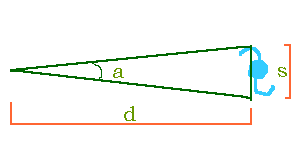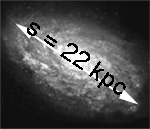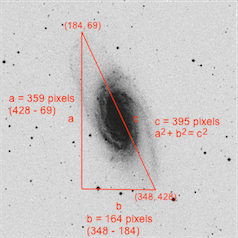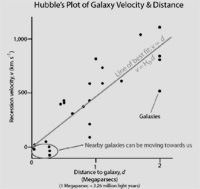
Hubble's Law Lab Exercise
Modified from a lab from the University of Washington Dept. of Astronomy (original)
Summary
The students will determine a value for Hubble's constant, based on their observations of the images and spectra of 10 spiral galaxies and then determine the age of the universe based on their Hubble constant.
Background and Theory
In the 1920's, Edwin P. Hubble discovered a relationship that is now known as Hubble's Law. It states that the recessional velocity of a galaxy is proportional to its distance from us:
v = Ho * d,
where v is the galaxy's velocity (in km/sec), d is the distance to the galaxy (in megaparsecs; 1 Mpc = 1 million parsecs; 1 parsec is approx 3.26 light years, the distance that light travels in 3.26 years), and Ho proportionality constant, called "The Hubble constant". Hubble's Law implies that a galaxy moving away from us twice as fast as another galaxy is twice as far away. The Hubble constant is a hotly contested quantity in astrophysics. In order to precisely determine the value of Ho, we must determine the velocities and distances to many galaxies.
The velocity, v, of a galaxy is measured using the Doppler effect. The radiation coming from a moving object is shifted in wavelength:

where  is the rest wavelength of the radiation, and
is the rest wavelength of the radiation, and  is the amount the radiation has been shifted (the observed wavelength minus the rest wavelength).
is the amount the radiation has been shifted (the observed wavelength minus the rest wavelength).
Wavelengths are usually measured in Angstroms (Å). The speed of light, c, has a constant value of 300,000 km/sec.
The quantity on the left side of the equation above is usually called the redshift, and is denoted by the letter z.
Velocity: We can determine the velocity of a galaxy from its spectrum: we measure the wavelength shift of a known absorption line and solve for v.
Example: An absorption line that is found at 5000Å in the lab is found at 5050Å when analyzing the spectrum of a particular galaxy. Therefore this galaxy is moving with a velocity v = (50/5000) * c = 3000 km/sec.
Distance: A trickier task is to determine a galaxy's distance, since we must rely on more indirect methods. One method for determining intergalactic distance is to assume that all galaxies of the same type are approximately the same physical size, no matter where they are. This has been shown to be generally true. This is known as "the standard ruler" assumption. Spiral galaxies, like our Milky Way Galaxy, are generally about 22 kiloparsecs (22,000 parsecs) across.
To determine the distance to a galaxy we only need to measure its apparent (angular) size, and use the small angle equation: a = s / d,
where a is the measured angular size (in radians not degrees!), s is the galaxy's true size (diameter), and d is the distance to the galaxy. So
distance = true size / angular size
d = s / a


Procedure
- Print out the worksheet. From the Galaxy List, choose the first galaxy, NGC 1357 - click on the "image" link.
- Find the angular size of the the spiral galaxy in the middle of the image. The images used in this lab are negatives, so that bright objects, such as stars and galaxies, appear dark. There may be more than one galaxy in the image; the galaxy of interest is always the one closest to the center.
To measure the size, first, click on one extreme end of the galaxy at either end of the longest diameter. Be sure to measure all the way to the faint outer edges. Otherwise, you will dramatically underestimate the size of the galaxy, and introduce a systematic error. The pixel value of the spot that you clicked will appear in the box to the right of the picture. Record these as X1, Y1 in your table. Next, click the other extreme end of the galaxy and record X2 and Y2.
Calculate the distance across the galaxy in pixels:

Remember the Pythagorean Theorem? a2 + b2 = c2
where a and b are two sides of a right triangle and c is the hypotenuse (the long side). The hypotenuse is the distance across the galaxy in our case. The lengths of sides a and be will b the difference between the x measurements (X2 - X1) and the difference between the y measurements (Y2 - Y1).
So, the distance across the galaxy in pixels is 
On a separate sheet of paper, calculate the distance across the image of the galaxy in pixels (show your work - Note, there is a calculator on the computer).
- Now you must convert this pixel distance into an angular size. The resolution of the detector on the telescope that took the pictures of the galaxies in this lab is 0.0093 µrad (microradians or 10-6 radians) per pixel. Remember, there are 2π radians in 360°. Convert your galaxy size in pixels into µrad by multiplying by 0.0093 µrad per pixel.
This is how large this galaxy appears from Earth. Of course it takes a very powerful telescope to see it.
- Now, using the small angle formula, determine our distance from the galaxy:
distance = true size / angular size
With true size = 22 kpsec and angular size in µrad, the distance will be in mega parsecs (Mpsec = million parsecs).
Wow, you just estimated the distance of our galaxy from another galaxy!
- Return to the Galaxy List and click on the "NGC 1357 Spectra" link.
- You will determine the redshift of NGC 1357 by comparing absorption and emmission lines in the spectrum of light coming from this galaxy to the known stationary wavelengths of some strong absorption and emmission lines, namely the calcium "K" and "H" absorption lines and the Hydrogen α
emmission line.
The lower left pane shows a portion of the spectrum of light coming from the galaxy NGC 1357. Note the two strong dips in the intensity of light at wavelengths of about 3965 angstroms and 4000 angstroms. These are the calcium K and H absorptions. Also note the short vertical lines labelled "Ca K" and "Ca H." These are the laboratory measured wavelengths of the calcium K and H absorptions, the "rest wavelength."
Click exactly on the line of the short vertical line labelled "Ca K" then scroll down beneath the graph and record the the wavelength in Angstroms, the "X value" under "Ca K rest" on the data sheet.
Click on the lowest point of the left of the two large absorption dips in the spectrum of galaxy NGC 1357. Scroll down and record the measured wavelength, "X value" under "Ca k meas." on the data sheet.
On your calculation sheet, calculate the difference in wavelength between the rest wavelength and the measured wavelength of the Ca K aborption line.
Now, calculate the redshift, z = Δλ / λ where λ is the actual rest wavelength for the Ca K absorption, 3933.7 Å.
- Finaly, determine the recessional velocity, v, the speed that galaxy NGC 1357 is moving away from our own Milky Way Galaxy
v = c z
where c is the velocity of light, 300,000 km/sec.
- Now repeat steps 1-7 for the remaining 9 galaxies -- Wait a minute! That's a lot of work. Now that you know how to do the calculations, let's use a spreadsheet that does the calculations automatically! Download the Hubble's Law Spreadsheet (Excel format) and open it.
Enter your X and Y coordinate data for NGC 1357 into the spreadsheet and see if your calculations were correct.
Get the coordinate data for the galaxy size and redshift for the remaining 9 galaxies and let the spreadsheet do the calculations. Make sure to save frequently as you work.
- Save your file and print it. Or you can also email the file to yourself or copy it to a flash drive if you have one with you and print it later.
- Make a graph of your data using the supplied graph paper, with distance on the x-axis, and velocity on the y-axis. Draw a straight line that best fits the points on the graph. This line must pass through the origin (the 0,0 point). (Why?)

- Caclulate the slope of this line (rise/run...). This is the Hubble constant. This describes the expansion of the universe in the funny units of km/sec per Mpc (recessional velocity per distance).
- And now for the age of the universe! If the universe has been expanding at a constant speed since its beginning, the universe's age would simply be
1/Ho.
First convert Ho to inverse-seconds (1/sec) by cancelling out the distance units, 1 Mpc = 3.09X1019 km.

![]() is the rest wavelength of the radiation, and
is the rest wavelength of the radiation, and ![]() is the amount the radiation has been shifted (the observed wavelength minus the rest wavelength).
is the amount the radiation has been shifted (the observed wavelength minus the rest wavelength).



